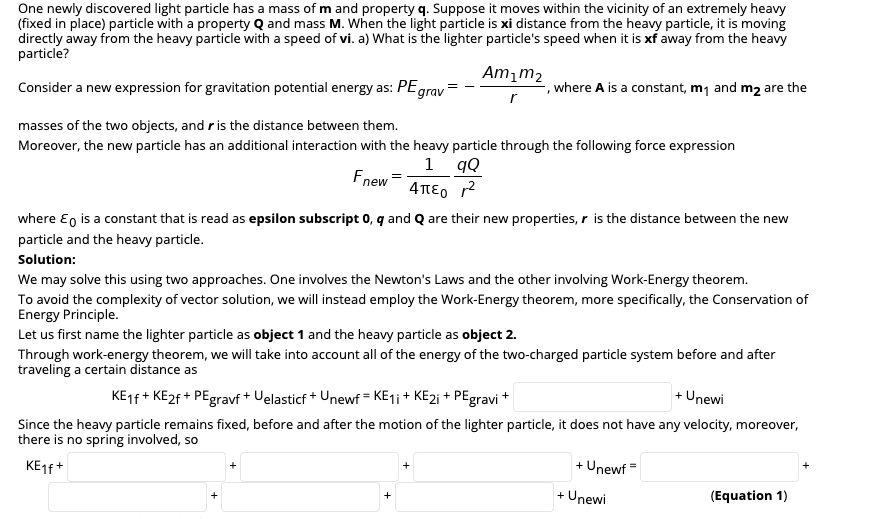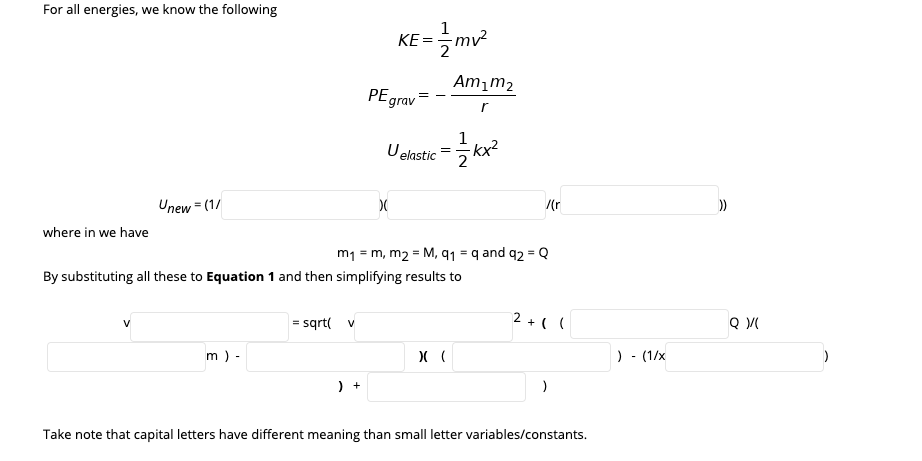Since the heavy particle remains fixed, before and after the motion of the lighter particle, it does not have any velocity, moreover, there is no spring involved, so + Unewf = KE1F+ + Unewi (Equation 1)
Since the heavy particle remains fixed, before and after the motion of the lighter particle, it does not have any velocity, moreover, there is no spring involved, so + Unewf = KE1F+ + Unewi (Equation 1)
Related questions
Question
FILL IN THE BLANKS WITH THE CORRECT ANSWERS.
The second picture is the continuation of the first one.

Transcribed Image Text:One newly discovered light particle has a mass of m and property q. Suppose it moves within the vicinity of an extremely heavy
(fixed in place) particle with a property Q and mass M. When the light particle is xi distance from the heavy particle, it is moving
directly away from the heavy particle with a speed of vi. a) What is the lighter particle's speed when it is xf away from the heavy
particle?
Am,m2
Consider a new expression for gravitation potential energy as: PE grav
,where A is a constant, m1 and m2 are the
r
masses of the two objects, and r is the distance between them.
Moreover, the new particle has an additional interaction with the heavy particle through the following force expression
1 qQ
4πεο r
Fnew
where Eo is a constant that is read as epsilon subscript 0, q and Q are their new properties, r is the distance between the new
particle and the heavy particle.
Solution:
We may solve this using two approaches. One involves the Newton's Laws and the other involving Work-Energy theorem.
To avoid the complexity of vector solution, we will instead employ the Work-Energy theorem, more specifically, the Conservation of
Energy Principle.
Let us first name the lighter particle as object 1 and the heavy particle as object 2.
Through work-energy theorem, we will take into account all of the energy of the two-charged particle system before and after
traveling a certain distance as
KE1F+ KE26 + PEgravf + Velasticf + Unewf = KE1; + KE2i + PEgravi *
+ Unewi
Since the heavy particle remains fixed, before and after the motion of the lighter particle, it does not have any velocity, moreover,
there is no spring involved, so
KE1F+
+ Unewf =
+
+ Unewi
(Equation 1)
+
+

Transcribed Image Text:For all energies, we know the following
KE= mv?
Amım2
PEgrav
Uelastic = kx
1
-kx²
2
Unew = (1/
where in we have
m1 = m, m2 = M, q1 = q and q2 = Q
By substituting all these to Equation 1 and then simplifying results to
= sqrt( v
2 + ( (
Q
m ) -
) - (1/x
) +
Take note that capital letters have different meaning than small letter variables/constants.
Expert Solution
This question has been solved!
Explore an expertly crafted, step-by-step solution for a thorough understanding of key concepts.
Step by step
Solved in 2 steps with 1 images
